Hanging succulents are an unusual change from flowering plants, and the majority of them are easy to care for. Whether you want to green up a tall bookcase, veranda, or the edges of a raised bed, there are many types of hanging succulents to choose from.
Let’s discover the most popular types and find out how to look after them.
What Are Succulents?
Succulent is an umbrella term for plants that store moisture. This can be in their leaves, stems, or roots.
The word succulent is taken from the Latin sucus, which means sap or juice in reference to their fleshy wet plant parts.
Succulents went out of fashion, but they are back and taking social media by force! You only have to check out succulents on Instagram to discover how popular they’ve become. In fact, succulents are so popular some in South Africa have become endangered in the wild by plant poachers.
And Hanging Succulents?
Hanging succulents are fleshy moisture-storing plants that hang or drape from their crown. In their native habitat, they may use their long branches to cling to other plants or spread across the ground.
Hanging Succulent Types
There are hundreds of types of hanging succulents, but here are some of the most popular varieties.
Burro’s Tail
One of the all-time favorite hanging succulents is Sedum morganianum, better known as burro’s tail.
Burro’s tail is native to Mexico and its fat green leaves hang from its thin stem resembling a tail, hence its name.
Its leaves are covered with a waxy pale blue substance called epicuticular wax, which helps keep moisture in and heat out. Blueberries do the same even though they are not related plants.
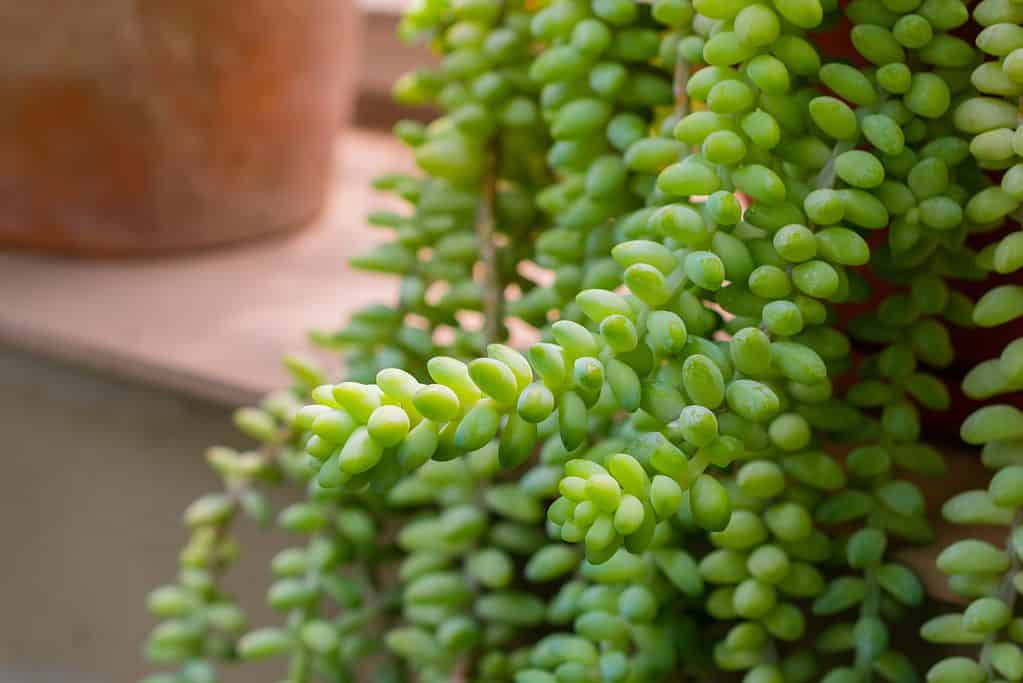
©Pickless/Shutterstock.com
String of Pearls
The Senecio rowleyanus is unmistakable with its long thin stems and rounded green beads full of liquid. It resembled a string of peas, but string of pearls sounds better!
They tend to live three to five years, but they are very easy to propagate, just snip off a piece of stem and push the cut end into the soil. In a week or two it’ll start growing.
In its native east Africa, string of pearls spreads over the ground secreting a sticky substance that glues it to rocks or other plants.
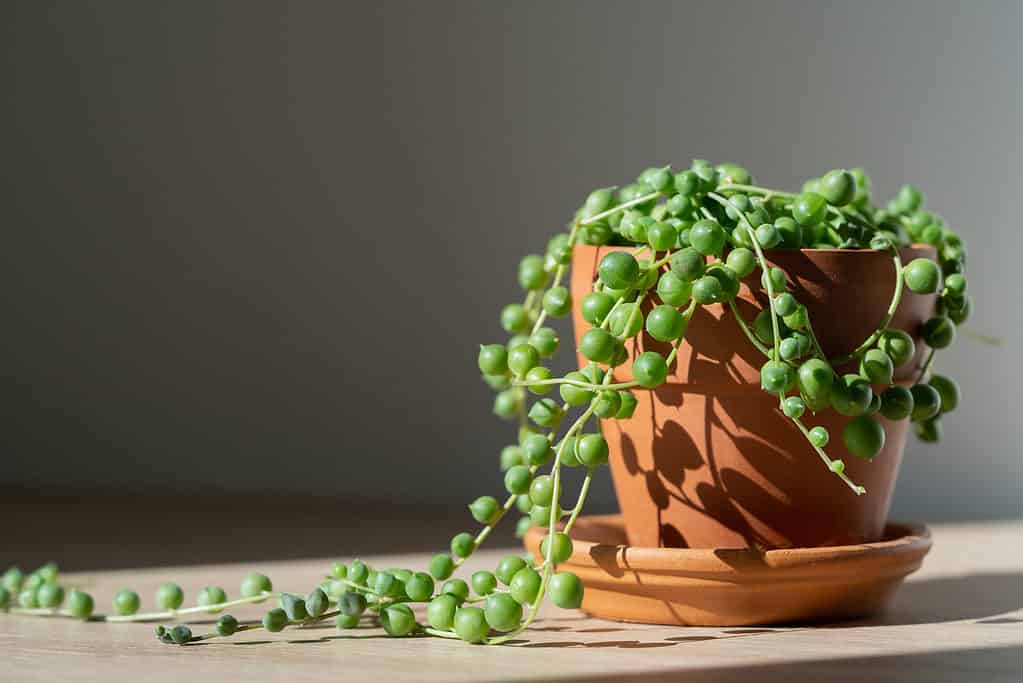
©iStock.com/Dima Berlin
Ruby Necklace
Othonna capensis is very similar to a string of pearls except when it’s grown in full sun the whole plant turns deep glowing burgundy!
In shade or partial shade, it remains green with its long thin stems dangling down with bean-like pods. Either way, it’s an attractive type of hanging succulent that’s easily propagated.
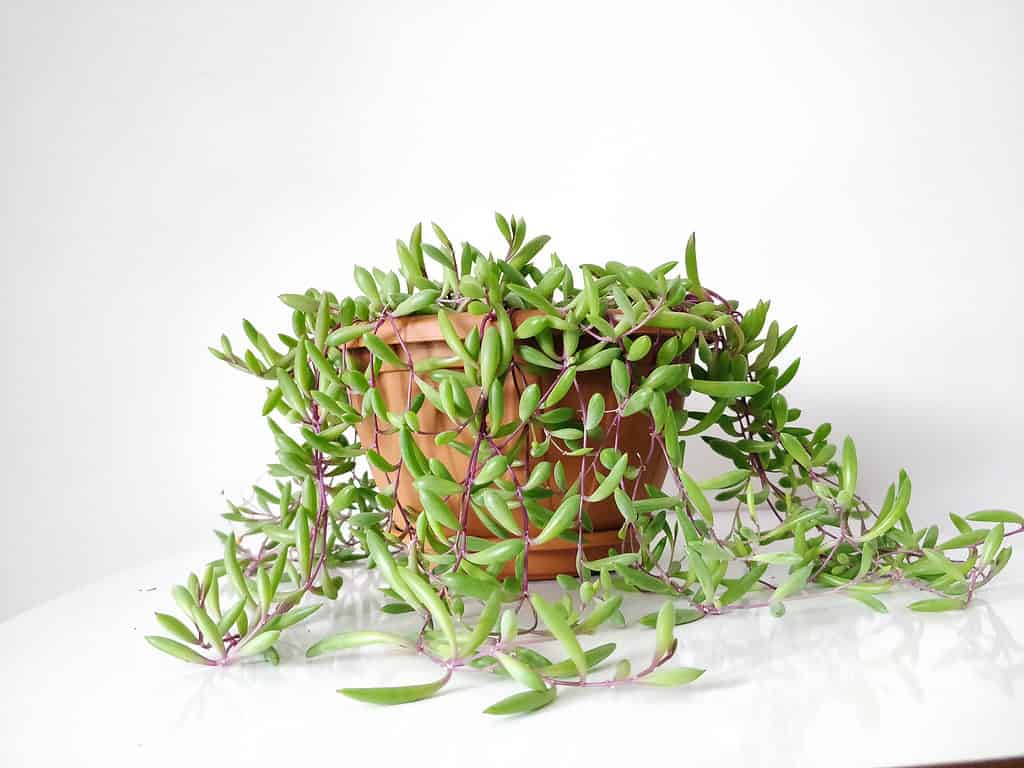
©iStock.com/yuqian liu
Calico Kitten
A pretty name for a pretty hanging succulent, the calico kitten is botanically named Crassula pellucida.
It has long trailing vines with heart-shaped leaves in a multitude of green, pink, and cream. In full sun the colors deepen, and it may produce tiny white flowers in spring.

©iStock.com/MichelR45
String of Hearts
Ceropegia woodii is native to South Africa and better known as the string of hearts. It has thin 12-inch long trailing stems with heart-shaped silver-green leaves studded every inch or so. In mature plants, leaf undersides often turn rich purple.
This is a beautiful hanging succulent and a very popular valentine’s gift.

©Job Narinnate/Shutterstock.com
String of Nickels
Another string type hanging plant is Dichidia nummularia, or the string of nickels. It’s a little less common than a string of pearls or hearts, but it’s still easy to grow.
Native to India, Asia, and Australia this hanging succulent shows off round, firm leaves like coins on thin stems. It’s an epiphyte that lives off trees in the wild, so it needs to be grown in orchid potting bark, not soil.

©ieang/Shutterstock.com
Rat Tail Cactus
A hanging cactus? Yes! Hanging cacti do exist and they look just as weird as you might expect.
The rat tail cactus is the Aporocactus flagelliformis and it’s known as the rat tail cactus because its stems are long, thin and bendable, so bendable they will hang over the edge of a container. It may produce pink tubular flowers in spring if the conditions are right.
This cactus has soft brown spines, so wear gloves when handling it.
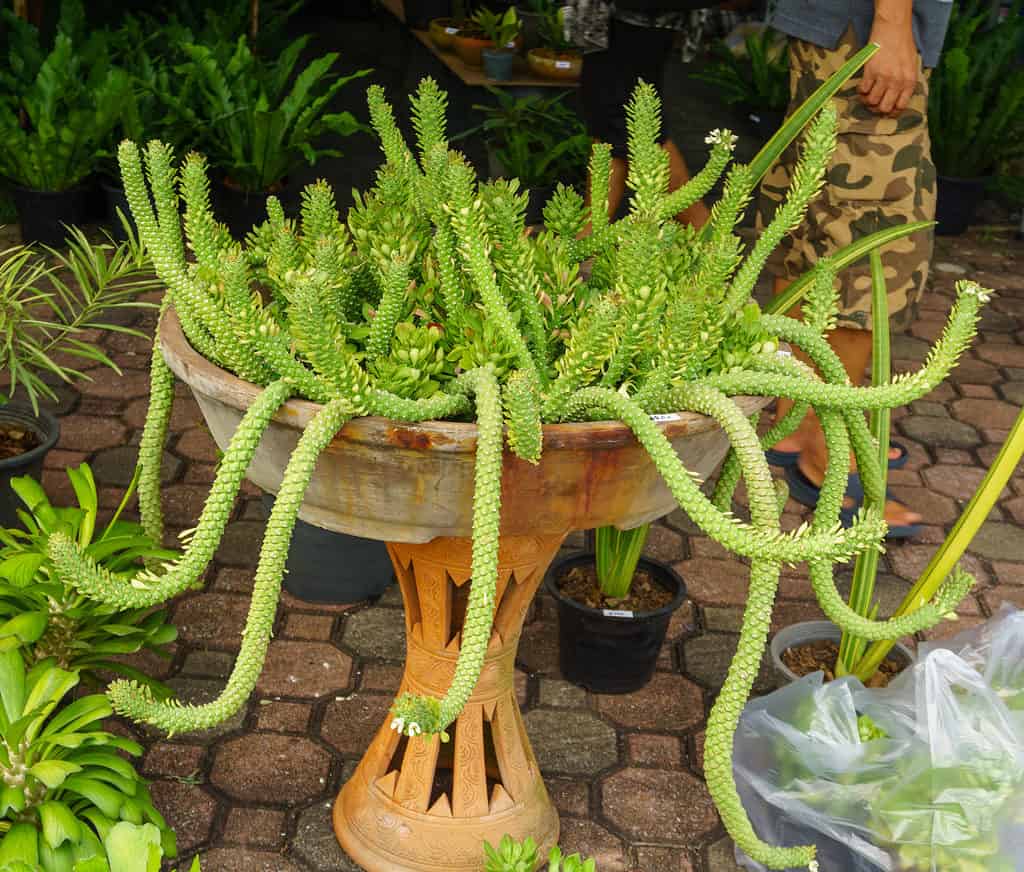
©moj0j0/Shutterstock.com
Monkey’s Tail
From rat tails to monkey tails, here’s the Bolivian native Hildewintera colademononis, also known as monkey’s tail.
This hanging cactus has long stems so coated in white spines that it’s hard to see its skin. These “tails” can grow up to eight feet long, but patience is required because it takes many years, and before they hang, the tails grow upright.
Bright blood-red flowers stud the stems if it’s happy, and it is worth the effort because they are spectacular.
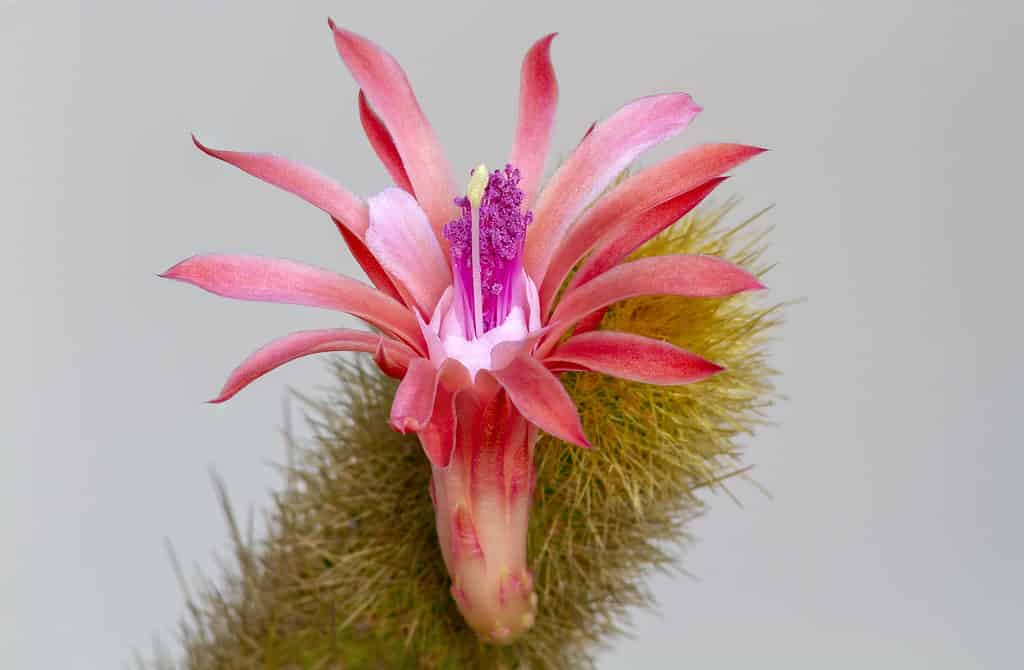
©Gilberto Mesquita/Shutterstock.com
Trailing Jade
Senecio jacobsenii is better known as trailing jade or Kleinia petraea. It’s native to Kenya and Tanzania, Africa, and has thick long succulent stems with egg-shaped leaves.
Each leaf can reach two to three inches long and because they tend to overlap, this hanging succulent has a full textured appearance.
It’s stems can reach up to four feet long, so its perfect for a tall bookcase or veranda, especially when its orange flowers bloom in fall.
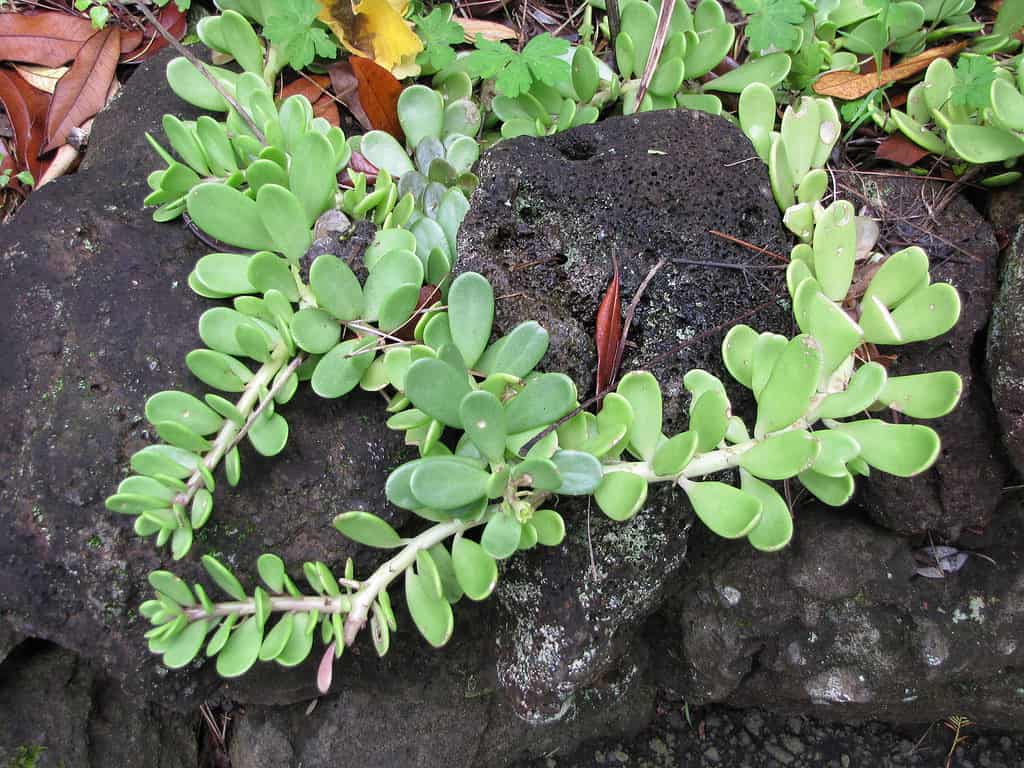
©Forest and Kim Starr / Flickr – License
Christmas cactus
An old favorite, Schlumbergera bridgesii, is also known as the Christmas cactus. It’s native to southeastern Brazil and there are several species and cultivars on the market.
A Christmas cactus has distinctive segmented leaves that are flat, serrated and create long stems.
If it gets lots of sun in September, this succulent will produce white, yellow, red or pink flowers in December, hence its name the Christmas cactus.
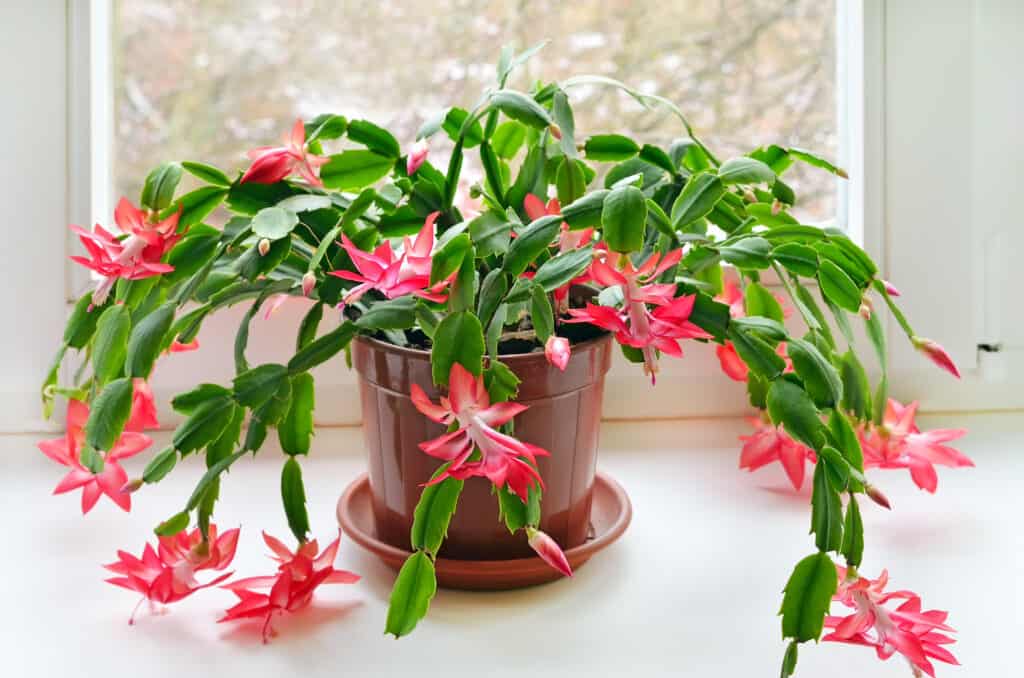
©iStock.com/Nadezhda_Nesterova
Dancing Bones
A totally crazy name for one of the weirdest types of hanging succulent! The dancing bones cactus is Hatiora salicornioides and it’s very unique because each leaf segment joins the next to resemble human leg bones.
This hanging succulent has long, thin segmented stems that start life growing vertically, before reaching their tipping point and bending over to reach 20 inches in length. In spring, and again in winter, prominent yellow flowers bloom from the bone tips.

© Dajra/Shutterstock.com
How To Care For Hanging Succulents
Hanging succulents need several things to thrive. The first is enough sunlight. The standard requirement for a succulent is six hours of light a day.
Inside, this means choosing a sunny spot like a windowsill, desk space, or hanging basket on a veranda, but it shouldn’t be in direct sun or it may scorch.
Soil is also important. Succulents need well-drained soil with plenty of perlite or a similar hard stone to aerate the soil. This allows excess water to escape.
How Do You Know When Hanging Succulents Need Water?
Hanging succulents need water when the top soil has dried out and it’s dry down to half an inch or so.
A hanging succulent in desperate need of water will have wrinkled fleshy parts as it empties out the last of its moisture. It may also drop leaves and spines to preserve its water levels.
The best way to water a succulent is by popping it in a sink of water for a few hours, then leaving it on the draining board to drain clear of excess water before it’s put back in the display pot. This makes sure water doesn’t hang around its roots for too long.
Try not to pour water on the top of a succulent. If it stays stuck in the crown it can cause rot and fungal problems. Always water succulents from beneath or around the roots if they are hanging over a wall or raised bed.
Troubleshooting Hanging Succulents
Even with the world’s best intentions, easy-to-grow hanging succulents can sometimes go haywire. Here are some of the most common problems.
My succulent has brown patches
Brown patches usually mean too much direct sun. Although succulents are light lovers, direct sun magnified through a window pane will scorch their fleshy leaves.
Hanging succulent is going yellow
Any succulent that’s turning yellow is usually suffering from too much water or fertilizer. By the time it’s yellowing it may be game over, but you can try to let the plant dry out. You might be lucky.
Succulent is tuning soft
Again, this is likely due to too much water or fertilizer. A soft succulent is rotting, so it’s best to get rid of it and try again with a less intensive watering regime.
Hanging succulent is only growing on one side
Succulents need plenty of light to grow and this is really emphasized when only one side gets the light!
A hanging succulent with extra growth on one side should be turned, so the shorter side receives sunshine too. Turn your hanging succulents every week or so to even out their light intake.
Types of Hanging Succulents: Which are Best?
There are so many different varieties of hanging succulents it’s fun to choose your favorite.
All of these hanging succulents need sunshine and sparse water. They will grow indoors and outside in the right conditions to brighten up your living space and make you smile.
Up Next
- 10 Hanging Plants To Consider In Your Home
- String of Pearls
- Succulent vs Cactus: What’s the Difference?
The post Types Of Hanging Succulents appeared first on AZ Animals.
from Animal News, Facts, Rankings, and More! - AZ Animals https://ift.tt/9oXOTbn